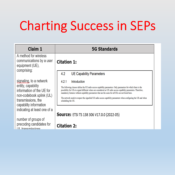In the high-stakes world of patent infringement litigation, claim charts are your armor and ammunition. Often, claim charts seem straightforward – a table mapping claim elements to an accused product. But dig a little deeper, and you’ll discover a powerful tool that goes far beyond mere mapping. Learn how to craft clear, concise, and logically organized charts that leave judges and juries with a clear understanding of your case. Here are 5 tips to make winning claim charts:
1. Understanding of Patent Claims (for DOE):
Understanding of patent claims includes not only the literal language but also any potential interpretations or equivalents. Make sure you explore doctrine of equivalence (DOE) during infringement analysis.
2. Jargon-Free Explanations: Avoid overly technical language. Use clear and concise explanations for non-technical jurors to understand the infringement arguments.
3. Terminology Consistency: Maintain consistency in terminology used throughout the chart. Define any technical terms not readily understood by a jury.
4. Storytelling with Evidences:
Connecting the claimed features with infringing product is nothing but a story telling. Understand your claim’s essential features and first put all the efforts to find evidences for the same. Ensure key evidences for such features are from potential infringing product and not any generic research publications/articles.
5. Mind the Hearing (Markman): Claim construction, also known as a Markman hearing, will essentially define the meaning of every claim term, therefore while preparing claim chart make sure your interpretation of the claim terms should not be ambiguous and back them with both intrinsic and extrinsic evidences for the meaning. Don’t overlook the Prosecution History.




Very interesting subject, appreciate it for putting up.Raise blog range